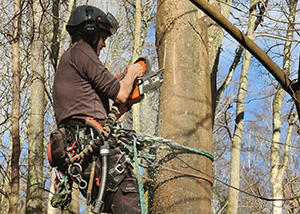South Norfolk: Carving out a future for Park’s wildlife

South Norfolk Council have taken an innovative approach to creating new wildlife habitats at Queen’s Hills Community Park in Costessey.
Using chainsaws and wood working tools, specialist contractors Conservation Arboriculture, have created deep cracks and shelters within trees, as well as creating areas of decay, to provide vital habitat for our native wildlife.
South Norfolk Council’s Cabinet Member for the Environment, Cllr Keith Kiddie, said:
“The 90 acres at Queen’s Hills Community Park is home to a wide variety of wildlife. To help it thrive we have worked with highly skilled arborists to mimic the natural crevices and nooks that are vital for the survival of animals like bats and birds .” “Mimicking habitats in this way is quite a new approach to supporting wildlife but there are many benefits, tree hollows for example are better insulated and less likely to be over-run with pests.”
Many of the Country’s native animals rely on tree hollows for their survival as places to shelter and rear their young. Large tree hollows can take 100 years or more to form naturally and even after the tree is dead, will still be used by tree dwelling animals and birds for centuries. When they fall to the ground and begin to rot, they continue to provide habitats for ground dwelling species and invertebrates.
Councillor Kiddie said:
“Years ago, it was a lot easier for animals to find hollows in trees, but because many of these old trees have been felled to make way for development or harvested as timber, it is now a lot more challenging. While we are planting new trees all the time, it will take many years before natural hollows form. That is why mimicking these hollows is such a great way to support our native animals.”
The Council have also intentionally caused damage to some of the younger trees to create areas of decaying wood within a living tree, a specialist and increasingly rare habitat for a wide range of wildlife, especially Invertebrates and they also support rare lichen and fungi.
Councillor Kiddie added:
“Places like our Community Park are a haven for our wildlife and it’s important we protect and support all the wonderful species of fauna and flora, so they can be enjoyed by future generations.”
Published: 19 February 2024